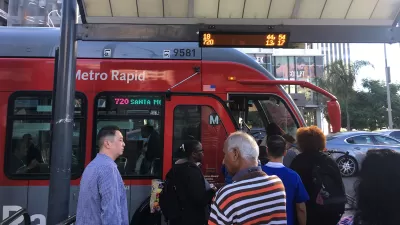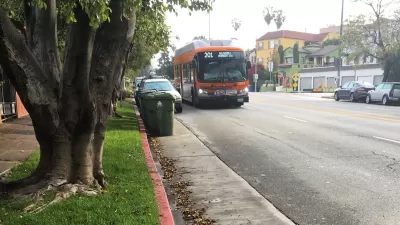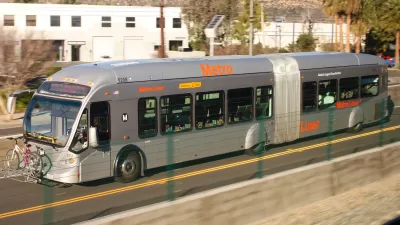Can Los Angeles convince drivers to cut the number of automobile trips in half while also transit frequency on several light rail lines?

Elijah Chiland reported at the end of April on an announcement of a "Green New Deal" by Los Angeles Mayor Eric Garcetti that sets a goal "to reduce the amount of driving in LA by nearly 50 percent in the next three decades."
Right now, LA drivers journey an average of 15 miles per capita per day, according to a report on the initiative released [in April]. That amounts to nearly 60 million miles driven per day within city limits.
Under Garcetti’s proposal, that would come down at least 13 percent by 2025 and 45 percent by 2050—a difference of more than 25 million miles each day, or 6.75 miles per person, should LA’s population stay relatively constant during that time.
Mayor Garcetti intends to achieve these ambitious goals by implementing safety improvements and streetscape projects already underway. Some experts are skeptical the city can achieve these goals, according to Chiland. "Juan Matute, deputy director of the UCLA Institute of Transportation Studies, tells Curbed the mayor’s goals are admirable—but won’t be easy to attain."
In Matute's own words: "Nothing that’s listed here will produce more than a 5 percent reduction […] It probably won’t bring them anything."
The actions of the regional transportation authority are already proving Matute's point about the difficulties of delivering on promises to cut driving. Since that announcement, the Los Angeles County Metropolitan Transportation Authority has decided to cut transit service on several of the region's light rail and high frequency bus lines, as reported in a much more recent article also by Chiland.
Metro’s Board of Directors [recently] approved a proposed $7.2 billion budget for the coming fiscal year, which begins in July. The financial plan includes a nearly 6 percent reduction in rail service hours, with the largest cuts planned on the Expo, Gold, and Blue lines. The change will result in fewer delays, according to Metro.
Chiland also notes that the board's action this week will also cut 75,000 hours of service from Metro's high frequency bus lines.
FULL STORY: Metro will scale back rail service, making for longer wait times

Montreal Mall to Become 6,000 Housing Units
Place Versailles will be transformed into a mixed-use complex over the next 25 years.

Planetizen Federal Action Tracker
A weekly monitor of how Trump’s orders and actions are impacting planners and planning in America.

Four Reasons Urban Planners Can’t Ignore AI
It’s no longer a question of whether AI will shape planning, but how. That how is up to us.

Bend, Deschutes County Move to Restrict Major Homeless Encampment
City and county officials are closing off portions of an area known as Juniper Ridge where many unhoused residents find shelter, hoping to direct people to housing and supportive services.

High Housing Costs Driving Down Transit Ridership in LA
When neighborhoods gentrify and displace lower-income residents, transit ridership suffers, new research shows.

Iowa Legalizes Accessory Dwelling Units
A new law will allow property owners to build ADUs on single-family lots starting on July 1.
Urban Design for Planners 1: Software Tools
This six-course series explores essential urban design concepts using open source software and equips planners with the tools they need to participate fully in the urban design process.
Planning for Universal Design
Learn the tools for implementing Universal Design in planning regulations.
City of Mt Shasta
City of Camden Redevelopment Agency
City of Astoria
Transportation Research & Education Center (TREC) at Portland State University
City of Camden Redevelopment Agency
Municipality of Princeton (NJ)
Regional Transportation Commission of Southern Nevada





























